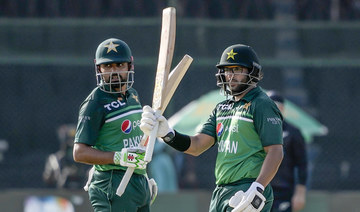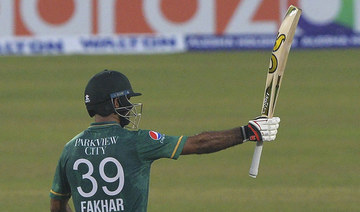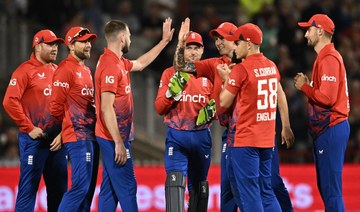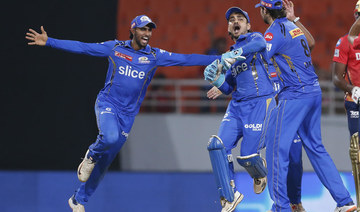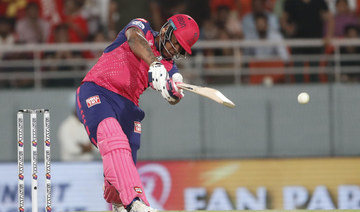KARACHI, Pakistan: Pakistan top-order batters continued to prosper as they beat under-strength New Zealand by 26 runs in the third one-day international on Wednesday for an unassailable 3-0 lead in the five-match series.
Opening batter Imam-ul-Haq made 90 off 107 balls and captain Babar Azam scored 54 as the home team raised a total of 287-6 after losing the toss and being asked to bat first.
Cole McConchie’s (64 not out) late counter-attack saw the 31-year-old smash New Zealand’s fastest half-century on ODI debut off 36 balls before the Kiwis were bowled out for 261 in the final over.
New Zealand made a solid start in a bid to keep the series alive when Tom Blundell (65), playing his first game of the series, and Will Young (33) put on 83 runs for the opening-wicket stand. But Young’s run-out in the 16th over saw the middle-order stifled by Pakistan spinners Shadab Khan and Mohammad Nawaz before Blundell too got run out while going for a second run with captain Tom Latham.
Daryl Mitchell, who scored centuries in the first two games, had two lucky escapes before he holed out in the deep after scoring 21 and Mark Chapman, who was the star for New Zealand in the preceding 2-2 drawn T20 series against Pakistan, was clean bowled by Naseem Shah for 13.
Left-arm spinner Nawaz, who dried up runs in the middle overs, injured his left index finger when he tried to hold onto a return catch of Mitchell and was brought to the hospital.
Part-time off-spinner Agha Salman made up for Nawaz’s absence, taking 1-42 off his nine overs as spinners got plenty of assistance off the wicket at the National Stadium.
Fast bowler Mohammad Wasim (2-50), one of the three changes Pakistan made from the last game, had Latham clean bowled as the Black Caps skipper attempted a ramp shot while exposing his stumps.
McConchie struggled against the spinners before taking charge in the final 10 overs against the pace as he smashed two sixes and six boundaries and brought up his half-century with a big six over mid-wicket against Shaheen Shah Afridi (2-53).
Earlier, Imam and Babar combined in a 108-run second wicket stand after Fakhar Zaman fell to Matt Henry (3-54). Fakhar’s two back-to-back centuries had earned Pakistan convincing wins at Rawalpindi before he played across the line and skied a catch to wicketkeeper Blundell.
Henry also broke the century-stand when Babar, who hit his eighth score of 50-plus in the last 11 ODIs, played the fast bowler back onto his stumps while going for an off drive. Imam showed plenty of patience but also fell in similar fashion when Adam Milne (2-56) struck in his return spell and Pakistan lost momentum in the death overs.
Mohammad Rizwan made 32 off 34 balls before he got caught by McConchie off Milne’s full toss before Shadab Khan’s hit a little cameo of 21 off 10 balls and provided a perfect finish by hitting Henry for a six off the final ball.
Karachi will host the remaining ODIs on Friday and Sunday as New Zealand wraps up its white-ball tour.
Pakistan beats New Zealand in 3rd ODI, clinches series
https://arab.news/yekjh
Pakistan beats New Zealand in 3rd ODI, clinches series
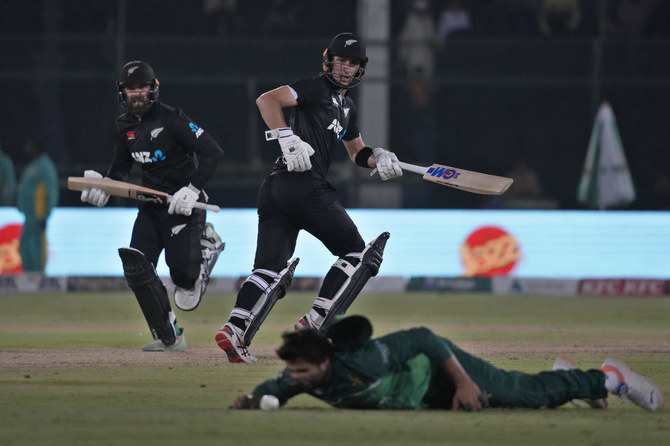
- Opening batter Imam-ul-Haq made 90 off 107 balls and captain Babar Azam scored 54
- Cole McConchie’s (64 not out) late counter-attack saw the 31-year-old smash New Zealand’s fastest half-century on ODI debut off 36 balls
Cricket’s rising demands are impacting physical and mental health
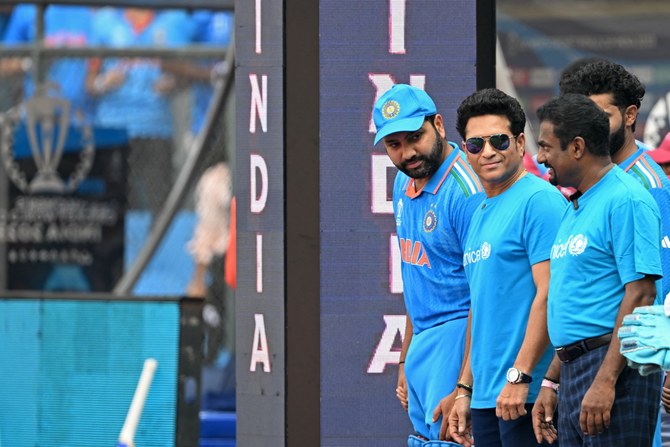
- Against a background of outstanding achievements are cries for help by professional cricketers who want to reduce their workload
Fred Trueman of Yorkshire and England was long regarded as his nation’s greatest fast bowler. In his prime, he bowled a thousand overs for Yorkshire during a summer.
This was an era when the only cricket matches on view, apart from Tests, were three-day county championships between 17 counties. In 1964, Trueman was the first bowler to claim 300 wickets in Test matches. When asked if he thought his achievement would be beaten, his response — typical of the man — was: “Aye, but whoever does it will be very tired.”
Since then, 36 bowlers have beaten Trueman’s record. Sri Lanka’s Muttiah Muralitharan claimed 800, followed by Australia’s Shane Warne with 708, and then there is England’s James Anderson, who has 700 and is due to play his last Test this year.
Anderson’s longevity and fitness is truly remarkable. He has sent down almost 40,000 deliveries in Test matches alone, the fourth highest among those taking more than three hundred wickets. He is not admitting to any tiredness and is regarded by some as having claim to be England’s finest quick bowler, rather than Trueman. Both their achievements, in different eras, are extraordinary. Trueman’s feat was accompanied by a bowling average of 21.57, only bettered by Malcom Marshall (20.94) and Curtly Ambrose (20.99). Anderson’s is 26.52.
It is against the background of these achievements that current cries for help by professional cricketers to reduce their workload should be gauged. Another of Yorkshire’s finest players is Joe Root who, in 140 Tests for England so far, has scored 11,626 runs. This puts him 10th on the all-time list of top Test run scorers. His workload has been intense for years, even more so when he captained England in 64 Tests, yet he rarely complains. Last week, however, he called for a major rethink of English cricket’s crowded schedule.
This was accompanied by the Professional Cricketers Association calling for change “before something disastrous happens.”
Based on a survey of professional male cricketers, the PCA revealed that key concerns are physical heath (81 percent), travel conditions (75 percent) and mental health (62 percent). Long-distance driving late at night, whether moving between matches or traveling home, is a particular worry. It is argued that player welfare and performance are compromised by the lack of time to recover, prepare and practice.
Professional cricket in England and Wales has a particular issue in that there are four men’s competitions shoe-horned into a window between mid-April and the end of September, with August given over entirely to The Hundred. Last year, proposals to reduce the amount of four-day county cricket and T20 cricket were rejected by the counties. Effectively, the 50 over competition has been downgraded because so few of the top players appear in it. According to Root, the objective should be to get “the standard of first-class and county cricket as close as you can to the international game.”
Professional cricketers in England and Wales have raised the issue of congested schedules and travelling pressure before. The explosion of T20 cricket in the last 20 years has increased this congestion and turned it into a more international concern. In India and Australia, for example, the distances between venues are much greater, with flying and its attendant risks additional factors.
In November 2023, during the announcement of India’s ODI squad for a series against Australia, India’s captain, Rohit Sharma, blamed excessive travel for injured players across the teams. It is in the interests of all cricket boards to narrow the gap between the standard of the breeding ground of first-class cricket and international cricket. Each one has different ways of doing so, a reflection of relative resources, geography and historic structures.
In India, reform is proposed for 2024-25. It seems likely that the Ranji Trophy, the country’s state-based long format game and the equivalent of the English county championship, will be split into two halves. White ball tournaments would be held in between. The main drivers behind this are to address variable winter weather conditions in the north and to allow longer gaps between matches to facilitate travel and recovery. This is similar reasoning to that aired by Joe Root and the PCA.
More forgiving schedules may release pressure on mental health, an often-overlooked facet of professional sport. There have been a number of high-profile cases in recent years in cricket. Azeem Rafiq’s experience of racism at Yorkshire was one. Another was Jonathan Trott, who played 52 Tests for England between 2009 and 2015. He left England’s tour of Australia in November 2013, unable to cope with the demands at that level. A man with very high levels of concentration lost them and referred to the impact of social media, saying: “People don't look you in the face and have a conversation and ask you how you are.”
Rohit Sharma, in the aftermath of India’s defeat in the 2023 ODI World Cup Final, was mentally shattered. He eschewed social media and opted out of ODI and T20I assignments against South Africa. Men’s cricket is a tough environment that appears not to appreciate that mental health issues are real. The growth of women’s cricket has brought about a change in approaches to mental health within the game. A webinar which I joined this week promoted by the Cricket Research Network discussed the different physiological challenges which women face in advancing in the game.
Quite what Fred Trueman would have made of this is an open question. He was an un-constituted menacing quick bowler who bullied opponents. It is not unreasonable to assume he would have been aghast at the notion of women playing professional cricket.
After his playing days were over, he became a pundit and commentator. His catch line was: “I don’t know what is going on.” He would be even more at a loss in today’s world of social media and Bollywood-style cricket.
US, Canada squads at the Twenty20 World Cup are a melting pot of nationalities
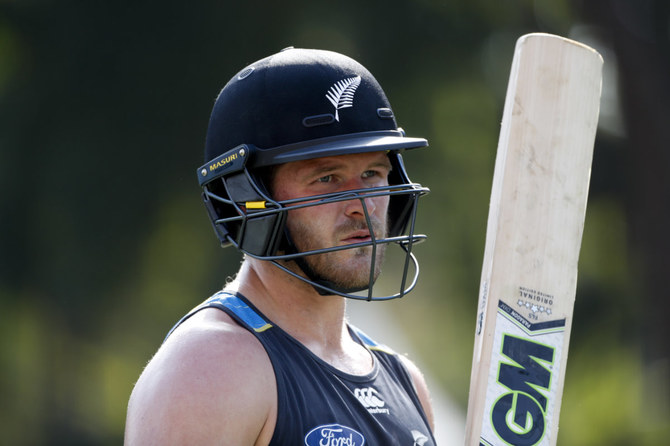
- The team provides a snapshot of US cricket at this formative stage, as Major League Cricket jostles for its place in a crowded sporting market
- Canada will be led by the veteran left-armer spinner Saad bin Zafar, who was born in Pakistan
- The US meet Canada in the tournament opener on June 1 and then there’ll be a step up for both teams in Group A
NEW YORK: The US cricket team which will co-host the Twenty20 World Cup may be a fitting cross-section of its country as a roster of migrants, a melting pot of nationalities and cultures.
The 15-man squad includes players born in India, Pakistan, New Zealand and South Africa. Home-grown players include vice-captain Aaron Jones, who was born in Queens, and allrounder Steven Taylor, of Hialeah, Florida.
The team provides a snapshot of US cricket at this formative stage, as Major League Cricket jostles for its place in a crowded sporting market. The squad includes foreign players drawn to America by the MLC and local players given the chance to play cricket at a professional level in the United States
The home team’s most recognized member is the former New Zealand allrounder Corey Anderson. The 33-year-old Anderson played 13 Tests, 49 one-day internationals and 31 T20 internationals for New Zealand between 2013 and 2018 in a career limited by injuries.
He earned a place in cricket history for his 36-ball century in a one-day international between New Zealand and the West Indies on New Year’s Day, 2014. Anderson also has played in T20 leagues in Australia, India, the Caribbean and UAE before finding an MLC home at the San Francisco Unicorns.
Anderson made his first half-century for the US in their T20 win over Canada last month.
Mumbai-born Harmeet Singh, who played for India at two Under-19 World Cups, was the star for the 19th-ranked US team earlier this week in an upset win over Bangladesh. It the only the second win over a full ICC member for the US
He scored 33 from the 13 deliveries he faced and shared an unbeaten, match-winning 62-run partnership with Anderson, who was unbeaten on 34.
“It means a lot to us to put on a show against Bangladesh. We are no walkovers,” Harmeet told ESPNcricinfo. “I think our potential is immense.”
The US meet Canada in the tournament opener on June 1 and then there’ll be a step up for both teams in Group A, which also includes India and Pakistan, fierce cricket rivals with enormous support, and Ireland.
Among the other foreign-born players on the US squad coached by ex-Australia batter Stuart Law is right-arm fast bowler Ali Khan, who moved with his parents from Pakistan to the US when he was 18.
He first played for the US team in 2016 and has also has played in the Indian Premier League, Caribbean Premier League and Pakistan Premier League, in Global T20 Canada and the Afghanistan Premier League.
Captain Monank Patel, a wicketkeeper-batsman, was born in India and settled in New Jersey after moving permanently to the US in 2016. He played at a junior level for Gujarat in India and played the first of his 47 one-day internationals and 23 T20 internationals for the US in 2019.
Andries Gous, another wicketkeeper-batsmen, was born in Welkom, South Africa, played for South Africa at under-19 level and played 60 first-class matches before relocating to the US in 2021. He and Patel were the highest scorers for the US in the recent five-match series against Canada.
Allrounder Milind Kumar is another India-born player who accumulated nine centuries in 60 first-class appearances for Delhi before making his home in the US
The Canada team scheduled to meet the US in the opening match is also a team drawn from many places and shaped by the evolution of a professional league at home.
Canada will be led by the veteran left-armer spinner Saad bin Zafar, who was born in Pakistan. He moved to Canada to study and was first named in the Canadian T20 team in 2008. Now 37, he has played 38 T20 internationals and once took two wickets without conceding a run in four overs in a T20 against Panama.
Jamaica-born batter Aaron Johnson, Pakistan-born left-arm fast bowler Kaleem Sana and Guyana-born right-arm quick Dillon Heyliger reflect the international makeup of the team which is coached by former Sri Lanka international Pubudu Dassanayake.
Nicholas Pooran powers Lucknow Super Giants to dead-rubber IPL win over hapless Mumbai Indians

- Mumbai out, Lucknow too failed to qualify for the playoffs
MUMBAI: Nicholas Pooran starred in Lucknow Super Giants’ 18-run victory over pre-tournament favorites Mumbai Indians in the last game of a disappointing Indian Premier League season for both teams Friday.
The maverick West Indies’ wicketkeeper-batsman hit eight sixes in his 29-ball 75 to take Lucknow to 214-6 after Mumbai skipper Hardik Pandya won the toss and chose to field first.
Mumbai crashed to 196-6 despite an impressive start by openers Rohit Sharma and Dewald Brevis in their rain-interrupted chase.
Pandya said that it was “quite difficult” for five-time champions Mumbai, who finished the 10-team league in last spot.
“This season we didn’t play good quality cricket and it cost us the whole season,” Pandya said.
Lucknow too failed to qualify for the playoffs and ended the tournament in sixth spot.
Captain KL Rahul said that it was “very disappointing.”
He blamed mid-season injuries to key players and said that they “didn’t play well enough collectively and couldn’t come together” as a team.
Earlier, Nuwan Thushara got Mumbai off to a great start and removed opener Devdutt Padikkal for a first ball duck.
Padikkal’s partner Rahul stitched together a 48-run partnership with Australia’s Marcus Stoinis, who fell to Piyush Chawla’s leg-spin for a 22-ball 28 in the sixth over.
Chawla also removed Deepak Hooda (11) to reduce Lucknow to 69-3 by the 10th over.
Thushara finally removed Pooran in the 17th over to end his match-defining, 109-run partnership with Rahul.
He also removed rookie Arshad Khan (0) in the same over and finished with 3-28 in his four-over spell.
Chawla removed Rahul, who took 41 balls for his 55 runs, in the 18th over and finished with 3-29.
Key unbeaten cameos by Ayush Badoni (22) and Krunal Pandya (12) took Lucknow to 214-6.
Mumbai’s openers took their team to 88 before Brevis fell for 23 in the ninth over.
India skipper Sharma top-scored with a 38-ball 68 with 10 fours and three sixes before he fell in the 11th over.
In between, Mumbai also lost their best T20 batsman, Suryakumar Yadav, for 0 and were reduced to 97-3 while out-of-form skipper Pandya fell for 16.
Indian rookie Naman Dhir hit five sixes and four fours in his unbeaten 28-ball 62.
Leg-spinner Ravi Bishnoi, who removed Sharma, and Afghanistan’s Naveen-ul-Haq, who removed Brevis, took four key Mumbai wickets between them.
Why English and Welsh cricket stands at a crossroads

- Since its inception in 2021, The Hundred format has been divisive on several levels, but ECB could implement changes to how it is run
On May 11, the second of a four-day county championship match unfolded in front of my eyes at the Utilita Bowl, Southampton. This is the home of Hampshire County Cricket Club. On a rare sunny day, there seemed to be around 600 other people watching, a majority in the members’ area.
Hampshire CCC is unusual in that it is one of three out of the 18 county cricket clubs in England and Wales that are not subject to member votes. It is owned by Hampshire Sport & Leisure Holdings, a private limited company which oversees sporting and leisure activities on the site. Its former chair, who was instrumental in saving the county from insolvency in 2001, owns 60 percent of the shares.
By coincidence, Hampshire’s opponents were Durham County Cricket Club, another county not subject to member votes. It is constituted as a Community Interest Company, a form of social enterprise. Northamptonshire County Cricket Club is the third one not to be subject to member votes, being constituted as a private company limited by guarantee.
The scene at Southampton would have been replicated at the other five county championship matches taking place on May 11. At the same time in Kolkata, the Knight Riders and the Mumbai Indians were preparing to play the 60th match of the 2024 Indian Premier League franchise competition. Average spectator attendance in the IPL is estimated to be 30,000. These two different models of promoting cricket may be about to coalesce, if proposed changes to the landscape in England and Wales come to fruition.
The changes center on The Hundred, a format of cricket introduced by the England and Wales Cricket Board in 2021. The two teams each play a single innings of 100 deliveries, divided into 20 overs of five deliveries, with two overs bowled from each end alternately. Each match is scheduled to last for two-and-a-half hours. Eight men’s teams and eight women’s teams comprise separate competitions with all matches played back-to-back on the same day at the same venue. The whole of August is allocated to The Hundred to the exclusion of other formats.
Ever since its inception, the tournament has been divisive on several levels. First, it has segregated the 18 counties into those who host The Hundred and those who do not. The eight participating counties are Glamorgan, Hampshire, Lancashire, Middlesex, Nottinghamshire, Surrey, Warwickshire and Yorkshire. However, the teams do not carry the county names, since the concept was to create city-based teams using existing county facilities. Agreement to progress with the tournament depended upon the support of excluded counties. This was achieved by the ECB’s offer to pay each county £1.3 million ($1.6 million) for their backing.
At a second level, there are differing opinions about the opportunity cost of this funding. The ECB receives around 75 percent of its income from the sale of broadcasting rights, a substantial part of which relates to Test-match cricket. Critics argue that using this money to support and develop a format which represents an existential threat to Test cricket is willful. They argue that the funds should be deployed in producing players for the longer rather than shorter formats.
On a third level, it is argued that the focus on eight counties, instead of 18, will hasten the demise of some of the latter, several of whom are in parlous financial circumstances. It is understood that, in the last two years, five counties have received financial help from the ECB. Overall debt levels in county cricket may be in the order of £200 million, some of this being incurred in stadium development designed to host international matches. In addition, operational costs have increased sharply in recent years.
It is in this context that the ECB’s current proposal to sell off 49 percent of equity in The Hundred has great attraction. The balance of 51 percent would be owned by the host county, which can decide to retain it all or sell part or all of it. The proceeds of the 49 percent are to be distributed to counties according to an undisclosed formula. The ECB requested that counties agreed to a “direction of travel” by May 10.
A divergence of opinion has emerged amongst the counties about the proposed model for distributing the spoils, split broadly between those who host The Hundred and those who do not. Needless to say, both sides appear to want more. In terms of numbers, some reports assert that the ECB’s sale of 49 percent equity might raise some $507 million (£400 million) for distribution, enough to salve the cash problems of a few counties. It is understandable that the non-hosting counties fear that they could get sold down the river.
There is already a fear that they are becoming marginalized by not being a host of The Hundred format. If the money raised by the ECB falls well short of the $507 million, then their financial problems may not be solved and their marginalization exacerbated. There are also legitimate concerns over governance and scheduling issues once private owners become involved. At this stage, the nature of private investors is unknown. It would be no surprise if Indian franchise owners show interest. However, it is reasonable to assume that they would not be content with either a minority stake or minority voice.
Cricket in England and Wales is at a watershed moment, caught in a maze of alternative possibilities, each one of which has unknown consequences. The ECB, under previous management, was the architect of this moment, through its introduction of The Hundred, which is contracted to run until 2028. In a twist of fate, it is now regarded as a medium for escape from impecunity. The alternative to equity sale is to do nothing and watch the system crumble. Equity sale will be tantamount to privatizing a part of that system. It was difficult to escape the feeling at Southampton that I was watching one part of that system which is heading for trauma.
Curran stars for Punjab as Rajasthan lose four in row

- Chasing a tricky 145 on a sluggish pitch, Punjab depended on Curran’s unbeaten 63 to achieve their target
- Impact substitute Ashutosh Sharma smashed 17 and the winning run to hand Rajasthan their fourth successive defeat
GUWAHATI, India: Skipper Sam Curran starred with bat and ball as Punjab Kings beat Rajasthan Royals by five wickets for a consolation win in the Indian Premier League on Wednesday.
Chasing a tricky 145 on a sluggish pitch, Punjab depended on Curran’s unbeaten 63 to achieve their target with seven balls to spare in Rajasthan’s adopted home ground in Guwahati.
Left-handed Curran put on a key 63-run stand with Jitesh Sharma, who made 22, and despite losing his partner in the 16th over steered the team home to lift them from the bottom of the 10-team table.
Impact substitute Ashutosh Sharma smashed 17 and the winning run to hand Rajasthan their fourth successive defeat in this edition of the T20 tournament.
“To be very honest, we have to sit back and accept that we are going through some failures,” Rajasthan skipper Sanju Samson said.
“You have to find out what’s not working well as a team. When you are getting to the business end, we need someone to raise their finger up and say I am going to win the game for the team. We have the players who can do that.”
The loss for Rajasthan hurt their chances of a top-two finish in the league stage a day after they confirmed their play-off spot.
Rajasthan, who stay in second place with one game in hand, and table-toppers Kolkata Knight Riders are the only two teams to have booked their play-off berth.
The top four teams make the play-offs, but the first and second-placed sides have the advantage of two chances to qualify for the final on May 26 in Chennai.
Punjab, who had already bowed out of the play-off race, kept the opposition down to 144-9 despite a 34-ball 48 by Riyan Parag.
Left-arm quick Curran bowled Yashasvi Jaiswal, for four, in the first over and then Samson departed for 18 off Nathan Ellis after a slow start.
Parag found Ravichandran Ashwin, who hit 28 off 19 balls, for company and the two attempted to push the scoring in their partnership of 50.
The rest of the batting faltered against a disciplined attack as Curran, fellow quick Harshal Patel and spinner Rahul Chahal took two wickets each.



